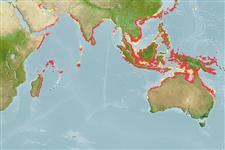Common names from other countries
>
Eupercaria/misc (Various families in series Eupercaria) >
Cepolidae (Bandfishes) > Cepolinae
Etymology: Acanthocepola: Greek, akantha = thorn + Latin, cepulla, cepa = onion.
More on author: Valenciennes.
Environment: milieu / climate zone / rango de profundidad / distribution range
Ecología
marino bentopelágico; rango de profundidad 10 - 80 m (Ref. 127963). Tropical; 31°N - 29°S, 47°E - 155°E
Indo-West Pacific: Persian Gulf, Vietnam, Indonesia (Java to Flores and West Papua), Philippines, Papua New Guinea (Port Moresby to Milne Bay), and Australia (Queensland; Northern Territory and Western Australia).
Tamaño / Peso / Age
Madurez: Lm ? range ? - ? cm
Max length : 30.0 cm TL macho / no sexado; (Ref. 11441)
Radios blandos dorsales (total) : 69 - 80; Espinas anales: 0 - 2; Radios blandos anales: 70 - 84; Vértebra: 45 - 49. This species is characterized by the following: HL 6.3-8.4 in SL; preopercle with 5 blunt spines, the longest at angle. Colouration: head and body orange-pink with double series of yellow spots (smaller than pupil) on the sides; dorsal fin yellow-orange, anal fin yellow and median fins with narrow black margins; paired fins yellow with pink rays (Ref. 127963).
Cross section: oval.
Occurs in muddy habitats, usually in large colonies, each individual with its own burrow. Rises high above the substrate in schools to feed when plankton drifts over, typically in vertical posture (Ref. 48635).
Life cycle and mating behavior
Madurez | Reproducción | Puesta | Huevos | Fecundidad | Larva
Kailola, P.J., 1987. The fishes of Papua New Guinea: a revised and annotated checklist. Vol. II Scorpaenidae to Callionymidae. Research Bulletin No. 41, Research Section, Dept. of Fisheries and Marine Resources, Papua New Guinea. (Ref. 6192)
IUCN Red List Status (Ref. 130435: Version 2025-1)
Threat to humans
Harmless
Human uses
Pesquerías: bycatch
Herramientas
Special reports
Download XML
Fuentes de Internet
Estimates based on models
Preferred temperature (Referencia
123201): 25.6 - 29.1, mean 28.3 °C (based on 674 cells).
Phylogenetic diversity index (Referencia
82804): PD
50 = 0.5625 [Uniqueness, from 0.5 = low to 2.0 = high].
Bayesian length-weight: a=0.00339 (0.00183 - 0.00629), b=2.85 (2.67 - 3.03), in cm total length, based on LWR estimates for this species & (Sub)family-body (Ref.
93245).
Nivel trófico (Referencia
69278): 3.4 ±0.45 se; based on food items.
Resiliencia (Referencia
120179): Alto, población duplicada en un tiempo mínimo inferior a 15 meses (Preliminary K or Fecundity.).
Fishing Vulnerability (Ref.
59153): Low vulnerability (20 of 100).
🛈
